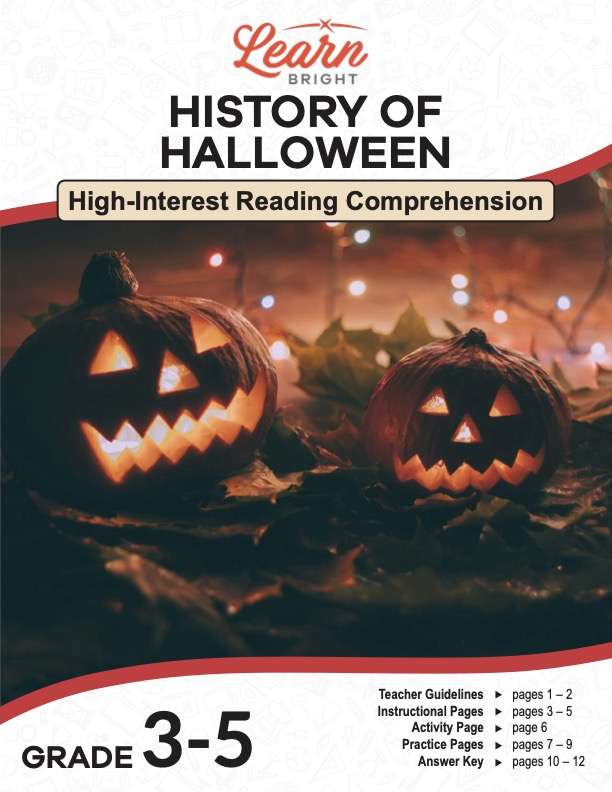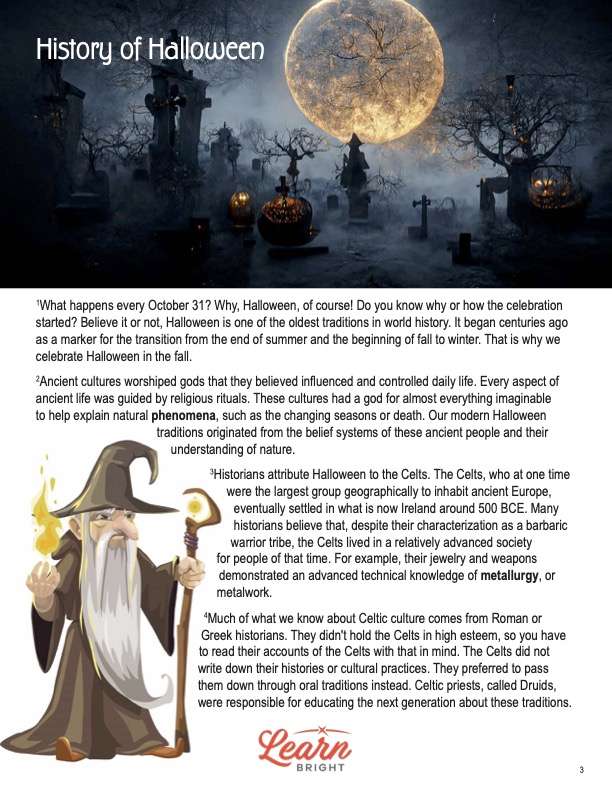Description
What our History of Halloween lesson plan includes
Lesson Objectives and Overview: History of Halloween is a high-interest reading comprehension lesson plan. As such, students will practice various close reading and comprehension skills. In addition, they will learn about the origins of this fun holiday. This lesson is for students in 3rd grade, 4th grade, and 5th grade.
Classroom Procedure
Every lesson plan provides you with a classroom procedure page that outlines a step-by-step guide to follow. You do not have to follow the guide exactly. The guide helps you organize the lesson and details when to hand out worksheets. It also lists information in the yellow box that you might find useful. You will find the lesson objectives, state standards, and number of class sessions the lesson should take to complete in this area. In addition, it describes the supplies you will need as well as what and how you need to prepare beforehand.
Teacher Notes
The paragraph on this page provides a little more information or guidance on what to expect from the lesson. It explains that you can teach this lesson in a whole-class setting or as an independent, small-group activity. You can use the blank lines to record any thoughts or ideas you have as you prepare.
HISTORY OF HALLOWEEN LESSON PLAN CONTENT PAGES
History of Halloween
The History of Halloween lesson plan contains three content pages. What happens every October 31? Why, Halloween, of course! Do you know why or how the celebration started? Believe it or not, Halloween is one of the oldest traditions in world history. It began centuries ago as a marker for the transition from the end of summer and the beginning of fall to winter. That is why we celebrate Halloween in the fall.
Ancient cultures worshiped gods that they believed influenced and controlled daily life. Every aspect of ancient life was guided by religious rituals. These cultures had a god for almost everything imaginable to help explain natural phenomena, such as the changing seasons or death. Our modern Halloween traditions originated from the belief systems of these ancient people and their understanding of nature.
Historians attribute Halloween to the Celts. The Celts, who at one time were the largest group geographically to inhabit ancient Europe, eventually settled in what is now Ireland around 500 BCE. Many historians believe that, despite their characterization as a barbaric warrior tribe, the Celts lived in a relatively advanced society for people of that time. For example, their jewelry and weapons demonstrated an advanced technical knowledge of metallurgy, or metalwork.
Much of what we know about Celtic culture comes from Roman or Greek historians. They didn’t hold the Celts in high esteem, so you have to read their accounts of the Celts with that in mind. The Celts did not write down their histories or cultural practices. They preferred to pass them down through oral traditions instead. Celtic priests, called Druids, were responsible for educating the next generation about these traditions.
Roots of Halloween
The roots of Halloween begin with the culture’s wrestling with the relationship between life and death. The Celts hypothesized that when a person died, they transitioned from physically living on this Earth to existing in a spiritual world. In many cultures, death is not the end of life but a transition to living in a spiritual world. The Celts believed the afterlife was a place of celebration! The burial of their dead was preceded by feasts and parties that honored the person who passed. So, what do the Celts, Druids, and parties have to do with Halloween? Great question!
The Celtic New Year festival was called Samhain (pronounced So-ween or Saw-wen), meaning “summer’s end” in English. The Celts believed that after a person died, they passed to the other world but could return as spirits to the side of the living. What we know about the Samhain rituals comes from Christian monks many years after the peak of Celtic culture. In writing the Celtic history, the monks eliminated many of the original rituals passed down from the Druids as they believed them to be pagan, or non-Christian. However, some traditions survived the monks’ revision of history.
The Celts stocked up on supplies for the coming winter as part of Samhain. The festival also included the tradition of slaughtering cattle and burning the bones in a large fire called a bone fire. Sound familiar? That’s exactly where the word bonfire comes from— bone fire! The Samhain festival welcomed guests from the afterlife. People even set places at their tables, inviting the spirits to join with the living in the festival!
Masks and the Great Potato Famine of 1845
Sometimes, spirits of those who had wronged others would appear. A living person who didn’t want to be recognized by the evil spirits disguised themselves with ash from the bone fire in order to blend in with other wandering spirits. Later, those who wanted to hide themselves began to wear masks. The practice became known as guising, which is pretending to be a malicious spirit.
In the 7th century, Pope Gregory III moved the All Saints Day holiday date from May 1 to November 1. All Saints Day honored the saints of the church who had passed away and gone to heaven. Because October 31 was the day before, it became a holy day known as Hallow Eve (hallow also means holy). Halloween is the contraction for Hallow Eve! Now we know where Halloween started, but how did it get to America?
Beginning in 1845, a terrible tragedy hit Ireland called the Great Potato Famine. The people of Ireland relied heavily on potatoes as their primary food source. A plant disease wiped out the crops, leaving most of Ireland in a food crisis. It is estimated that more than a million men, women, and children perished from starvation. Millions of people immigrated from Ireland—a large portion to the United States—searching for a better life. They brought with them All Hallows’ Eve, All Saints Day, and many other cultural traditions, including jack-o’-lanterns!
Jack-o’-Lanterns
The jack-o’-lantern tradition exists because of an Irish folk tale about a con man and thief named Stingy Jack. He was denied entry into heaven when he died because of his crimes, but he tricked the Devil into agreeing not to send him to the underworld. So, Stingy Jack was left to roam the Earth forever. At night, he carried a lamp made from a turnip with an ember from the underworld inside to light his way.
As part of the All Hallows’ Eve tradition, the Irish carved faces on the turnips and placed embers inside them—jack-o’-lanterns! According to the folk tale, the turnip lantern kept evil spirits like Stingy Jack away. When they arrived in America, the Irish exchanged turnips for pumpkins. They were easier to carve.
In the United States, Halloween continually evolves. While some religious groups abstain from participating in Halloween activities, most communities embrace the fun atmosphere. On October 31, many schools sponsor costume parades of characters from popular books to promote reading. Some churches sponsor trunk-or-treat events in the community as alternatives to knocking door to door. Costume parties are popular fundraising activities for community organizations. Halloween has come a long way from its Druid roots!
HISTORY OF HALLOWEEN LESSON PLAN WORKSHEETS
The History of Halloween lesson plan includes two worksheets: an activity worksheet and a practice worksheet. Each one will help students solidify their grasp of the material they learned throughout the lesson. You can refer to the classroom procedure guidelines to know when to hand out each worksheet.
COSTUME CREATION ACTIVITY WORKSHEET
For the activity, students will choose a favorite book or story and create a costume of their favorite character. Using the template on the page, they will share details about their character and explain how that character is similar to them. If they want, students can dress up in the costume they created.
PRACTICE WORKSHEET
The practice worksheet requires students to answer a series of 15 questions. These questions all relate to the content pages, so students will need to refer to them often for the answers. In addition, each question provides which reading tool the question corresponds to, such as text feature, vocabulary, or comprehension.
Worksheet Answer Keys
At the end of the lesson plan document is an answer key for the practice worksheet. The correct answers are all in red to make it easier for you to compare them with students’ responses. If you choose to administer the lesson pages to your students via PDF, you will need to save a new file that omits these pages. Otherwise, you can simply print out the applicable pages and keep these as reference for yourself when grading assignments.









